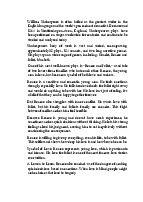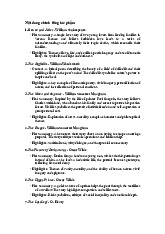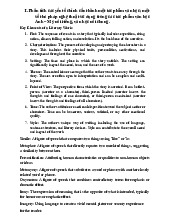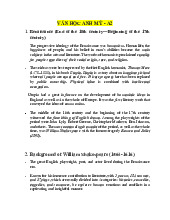




Preview text:
lOMoAR cPSD| 58950985
Đề cương văn học Anh – Mỹ
I. Phân tích các yếu tố chính cấu thành một tác phẩm văn học; một số thủ
pháp nghệ thuật sử dụng trong các tác phẩm văn học Anh – Mỹ nói riêng, văn
học nói chung Key Elements of a Literary Work:
1. Plot: The sequence of events in a story that typically includes exposition,rising
action, climax, falling action, and resolution. It's the backbone of the narrative.
2. Characterization: The process of developing and portraying the characters ina
story. This includes their physical traits, personalities, motivations, and
development throughout the narrative.
3. Setting: The time and place in which the story unfolds. The setting
cansignificantly impact the mood, tone, and themes of a work.
4. Theme: The central idea or message that the author wants to convey
throughthe story. Themes are often open to interpretation and can be complex and multi-layered.
5. Point of View: The perspective from which the story is narrated. It can befirst-
person (narrator as a character), third-person limited (narrator knows the
thoughts and feelings of one character), or third-person omniscient (narrator
knows the thoughts and feelings of all characters).
6. Tone: The author's attitude or emotional disposition toward the subjectmatter
or characters. Tone can be humorous, serious, satirical, or any other emotional quality.
7. Style: The author's unique way of writing, including the use of
language,sentence structure, and literary devices. Style can contribute to the
overall mood and impact of the work. Literacy devices:
Simile: A figure of speech that compares two things using "like" or "as
Metaphor: A figure of speech that directly equates two unrelated things, suggesting a similarity between them
Personification: Attributing human characteristics or qualities to non-human objects or ideas.
Metonymy: A figure of speech that substitutes a word or phrase with another closely related word or phrase.
Oxymoron: A figure of speech that combines contradictory terms for emphasis or dramatic effect.
Irony: The expression of meaning that is the opposite of what is intended, typically
for humorous or emphatic effect.
Imagery: Using language to create a vivid mental picture or sensory experience for the reader.
Alliteration: The repetition of consonant sounds at the beginning of words in close proximity. lOMoAR cPSD| 58950985
Repetition: The deliberate use of repeating words, phrases, or sounds for emphasis or rhetorical effect.
Euphemism: A word or phrase used to substitute a harsh or unpleasant term, often
to make it sound less offensive
Cliché: An overused phrase or expression that has lost its originality or impact.
Hyperbole: Exaggerated statements or claims not meant to be taken literally, used
for emphasis or dramatic effect.
Allusion: A passing or indirect reference to a well-known person, event, or work of
art, often used to enhance meaning or add depth to a literary work.
Foreshadowing: A literary device that hints or suggests what will happen later in a
story, often creating suspense or anticipation. II.
Kiến thức sơ lược về các thời kì văn học Anh – Mỹ
1. English literature in Medieval period
1.1. Anglo – Norman Period (11th – 13th centuries)
In the year 1066, a strong feudal monarchy was established. The power of
In the year 1066, a strong feudal monarchy was established. The power of
- In the year 1066, a strong feudal monarchy was established. The power of the
Catholic Church has become very great.
- 3 languages were spoken in England. The language of nobility was French,
the churchman used Latin and the common people spoken Anglo-Saxon.
- The literature of the Church was scholastic, moralizing, and it supported the feudal system.
- The Anglo-Saxon composed their own popular poetry.
- Genres: Fabiliaux, funny stories
1.2. Pre-renaissance (14th – 15th centuries)
- The 14th century was a difficult time for England. The war brought great
hardships to the common people. At the same time England suffered from 3 epidemics of the plague.
- The townpeople, that are the craftmen and the tradesmen, were becoming an important social force.
- The English nation was being formed; English became the spoken language
of the country -> English literature was born.
- Geoffrey Chaucer (1340-1400), the first poet who pave the way for English
realistic literature, free the influence of the Church.
2. English literature in Renaissance
2.1. The Elizabethan Era (16th century)
3 Engl.ish became the first-rate Ẻuropean power under the reign of Queen lOMoAR cPSD| 58950985
- English became the first-rate European power under the reign of Queen
Elizabeth I (1533-1603, Queen of England and Ireland 1558-1603). At that
time her country was called MERRY ENGLAND. (The development of the
economy - a development of culture and other social aspects)
- This was also the time of the RENAISSANCE and the REFORMATION in
literature and the age of great playwrights ( writers of plays).
- The climax of this period is WILLIAM SHAKESPEARE(the greatest writers
in the English language, born in 1564), the greatest playwright of the age
II.2. The Puritan age (The 17th century)
- The Puritan age began in 1626 (the 17th century). It was the age of religious
and political controversy Puritanism (Thanh Giáo) = 'Protestantism objected
to the reformation by Q. Elizabeth), the age of Protestantism having the idea
of a pure religion and harsh life (Anglicanism (Giáo phái Anh): Henry VIII
1491-1547, King of England 1509-1547).
- The main figure of this age is JOHN MILTON (1608-1674). He was a blind
poet. His great poems are PARADISE LOST, PARADISE REGAINED
II.3. The Enlightenment Age (The 18th Century)
- The 18th century: The age of reason or enlightenment marked by the scientific
and technological evolution in England and France Rationalism
(chu nghia duy li) prevailed and influenced writers
- Feature: Prose fiction (tác phẩm văn xuôi) or the novel
- Two typical figures: DANIEL DEFOE (1660-1731), a minister with
ROBINSON CRUSOE and JONATHAN SWIFT (1667-1745) with GULLIVER'S TRAVELERS
II.4. Romanticism (The late 18th century)
In 1789, WILLIAM WORDSWORTH (1770-1850) with coleridge a book of lyrical
poetry (thơ phổ nhạc) THE LYRICAL BALLAD
The principles of Romanticism (chủ nghĩa lãng mạn) - Ordinary life
- Written in the language of ordinary men & women
- Nature is the most suitable subject
4. English literature in late 19th century and early 20th century.
- The Victorian age (the 19th century) in 1857, queen Victoria ascended the
throne, ushering the victorian age with the Quality and excellence of literature in poetry, prose, and novels lOMoAR cPSD| 58950985
- In the field of prose, the Representative is Sir Walter Scott (1771-1832). He is
remembered as the creator of the English historican novel with ivanhoe.
- The representative novelist of this age is CHARLES DICKENS (1812-1870)
with a lot of depictions of the working people in his novels. His most popular
books are: THE PICKWICK PAPERS, DAVID COPPERFIELD OLIVER TWIST, THE CHRISTMAS BOOKS
- We should also mention another novelist: WILLIAM MAKEPEACE
THACKERAY (1811-1860) with VANITY FAIR mocking(che nhao) at the
follies of the upper classes of society. It also is the novels has the sub-title “A Novel Without a Hero”
5. English literature in 20th century and contemporary literature The
English literature in the 20th century lays more emphasis on:
- Realism and philosophy of life.
- Social reflection: and showing life as it is.
- Changes in life and thought which are brought about by the two world wars.
- Some typical figures: H.G. WELLS (1866-1946) with THE TIME
MACHINE. SOMERSET MAUGHAM (1874-1965) with OF HUMAN
BONDAGE. GEORGE BERNARD SHAW (1856-1950): a playwright with MAN AND SUPERMAN.
A BRIEF OF AMERICAN LITERATURE
1. Colonial and Early American Literature (1607-1800): The earliest
Americanliterature consisted primarily of religious and historical writings by
English settlers. Prominent figures include Anne Bradstreet, known for her
poetry, and Jonathan Edwards, a preacher. The Great Awakening in the mid-
18th century influenced a shift towards more emotional and personal expressions.
2. The Enlightenment and Revolutionary Period (1750-1800): This era saw
theemergence of political writings and pamphlets advocating for
independence. Thomas Paine's "Common Sense" and the Federalist: Papers
are notable examples. Early American novels, such as Washington Irving's
"Rip Van Winkle" and James Fenimore Cooper's "The Leatherstocking Tales,"
also appeared during this time.
3. Romanticism (1800-1860): The early 19th century marked the rise
ofAmerican Romanticism. Writers like Edgar Allan Poe, Nathaniel lOMoAR cPSD| 58950985
Hawthorne, and Herman Melville explored darker themes, while poets like
Walt Whitman celebrated individualism and nature. Ralph Waldo Emerson
and Henry David Thoreau played key roles in the Transcendentalist movement.
4. The American Renaissance (1830-1865): This period, often considered
asubset of Romanticism, produced some of the most enduring works in
American literature. Notable figures include Nathaniel Hawthorne, Herman
Melville, Emily Dickinson, and Walt Whitman.
5. Realism and Naturalism (1865-1914): Post-Civil War literature
shiftedtowards realism, portraying everyday life and characters in a more
truthful manner. Mark Twain's "Adventures of Huckleberry Finn" is a
significant work of this era. Naturalism, influenced by scientific determinism,
emerged with writers like Stephen Crane and Theodore Dreiser.
6. The Harlem Renaissance (1920s): This cultural, social, and artistic
explosionin the African American community led to a flourishing of literature,
music, and visual arts. Key figures include Langston Hughes. Zora Neale Hurston, and Claude McKay.
7. The Lost Generation (1920s-1930s: Following World War I, writers like
F.Scott Fitzgerald and Ernest Hemingway explored the disillusionment and
trauma of the war. Their works often reflected a sense of loss and questioning of traditional values.
8. Modernism (1914-1945): A literary movement characterized by a breakfrom
traditional forms and a focus on individual consciousness. T.S. Eliot, William
Faulkner, and Virginia Woolf are influential modernist writers.
9. Post-World War II Period (1945-Present): The second half of the 20thcentury
saw the emergence of diverse voices, including the Beat Generation (Allen
Ginsberg, Jack Kerouac), the Confessional poets (Sylvia Plath, Anne Sexton),
and the rise of multicultural literature with authors like Toni Morrison and Amy Tan.
10.Contemporary Period (Late 20th Century-Present): American literature
continues to evolve, encompassing a wide range of voices, genres, and
perspectives. Notable contemporary authors include Don DeLillo, Jhumpa Lahiri. and Colson Whitehead.



